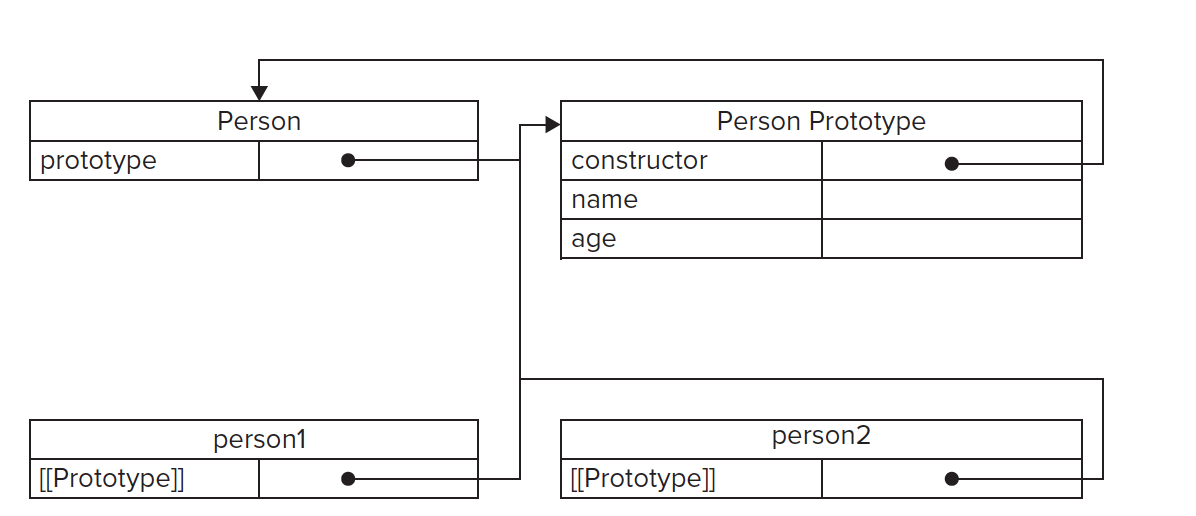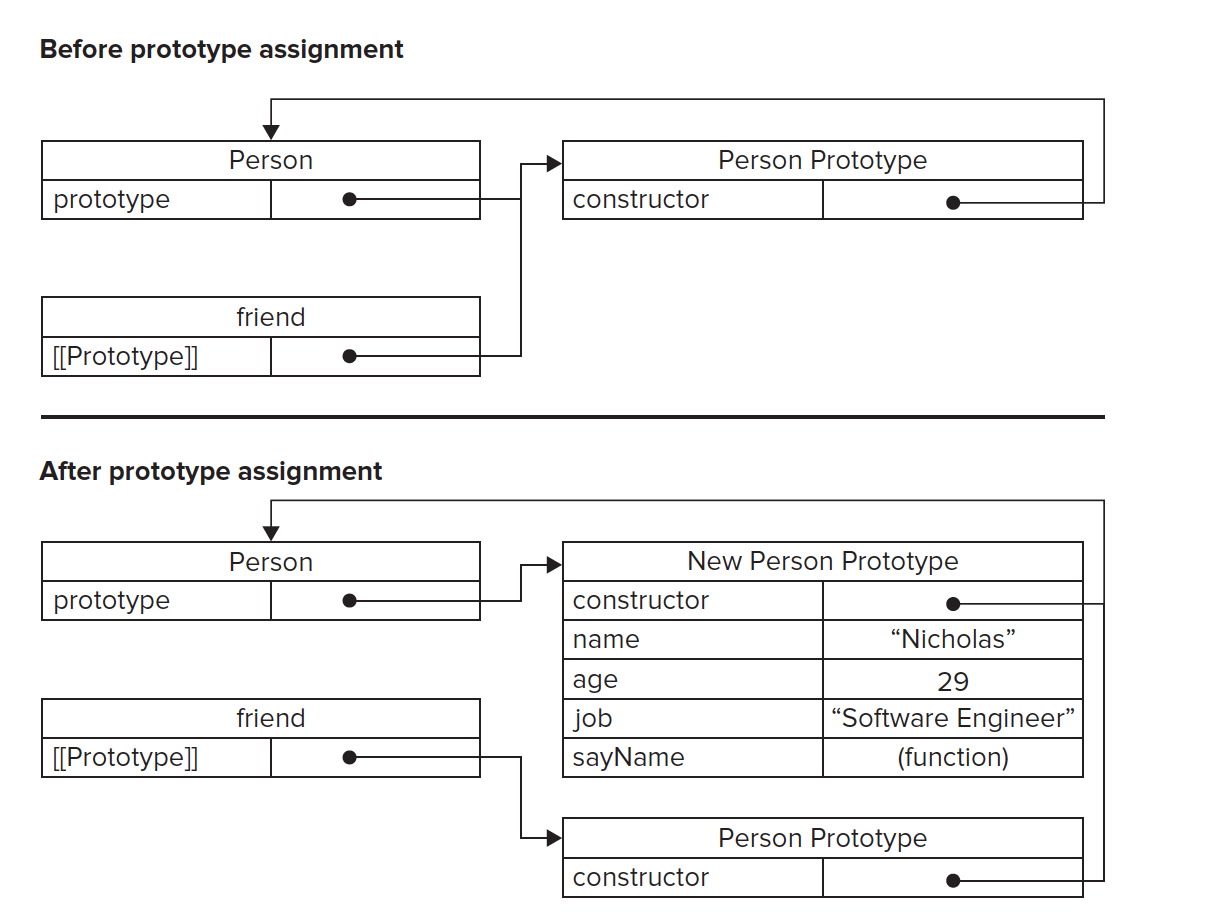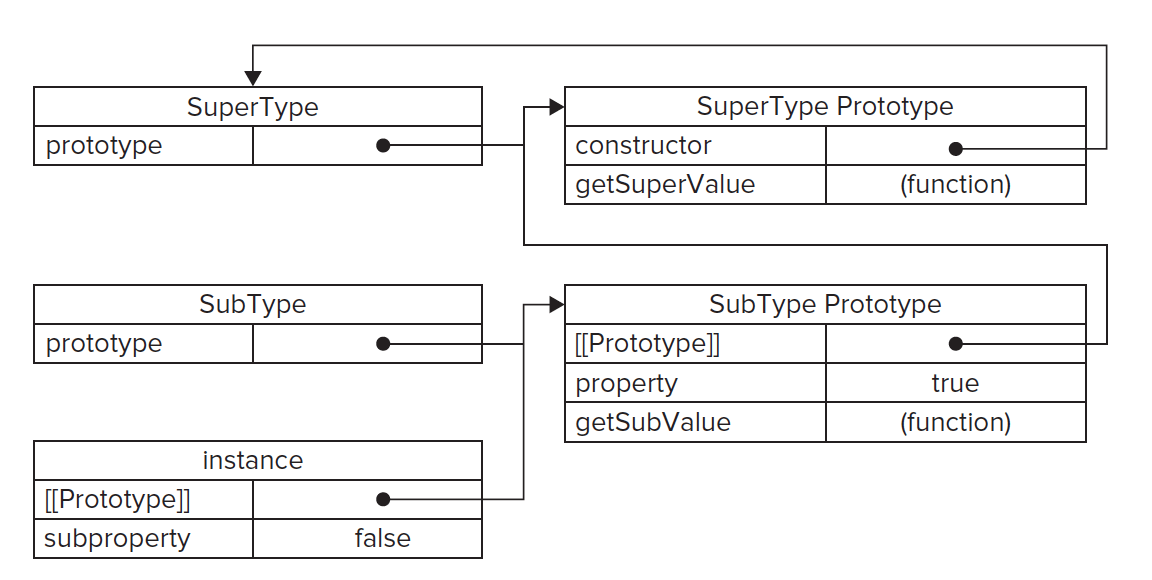Javascript Basics
This post is about self-learning. I like to note down my understanding of concept that I am learning for better understanding.
Please note that information in this post may not be accurate or not as per standards
Javascript Object - Ways to create javascript object
Factory Pattern
function createPerson(name, age) {
var obj = new Object();
obj.name = name;
obj.age = name;
obj.sayName = function () {
console.log(this.name);
};
return obj;
}
var person = createPerson("abc", 29);Problem with this approach is that all object created with this will have type of Object so it leads to problem of Object Identification
Constructor Pattern
function Person(name, age) { // by convention constructor function begin with capital
this.name = name;
this.age = age;
this.sayName = function () {
console.log(this.name);
};
}
var person = new Person("abc", 29);It solved the Object identification which is great advantage over factory pattern
Contructors defined in this way are defined in global object so window.Person and window.person are accessible.
Only difference between functions and contructors is the way they are called, for constructor we use new Person and functions are called normally
so above contructor can be called like this
var person = new Person("abc", 29); // constructor
Person('abc', 29); adds to windows object so window.sayName prints abc
The problem with contructor function is that each object has its own method even though they serve the same purpose, here sayName is creating for every Person object. to fix this we can move sayName outside contructor function
function Person(name, age) {
this.name = name;
this.age = age;
this.sayName = sayName;
}
function sayName() {
console.log(this.name);
};
var person = new Person("abc", 29);but this leads to issue of populating global space with sayName so we have now window.sayName function
Prototype Pattern
function Person() {}
Person.prototype.name = "Nicholas";
Person.prototype.age = 29;
Person.prototype.sayName = function () {
console.log(this.name);
}
var person = new Person();
person.sayName(); // NicholasEach function is created with prototype property, prototype property is an object containing properties and methods that would be available to instance of reference type. As name suggest its actually a prototype of object that will be created when constructor is called. All properties and methods are shared across instances.
When function is created its prototype property is also created and gets a property called constructor that points back to function of which prototype is property of (properties passed through constructor will also be added), so Person.prototype.constructor points to Person.
Whenever new instance is created that instance has one internal property (__proto__ or [[Prototype]]) that points to constructor prototype not to constructor directly.

Prototype Constructor Instance Relation
Although prototype property are readable but its not possible to overwrite them, for e.g.
var person1 = new Person();
var person2 = new Person();
person1.name = "xyz"; // this only mask the prototype property
person2.name; // prints abc as its not possible to overwritehasOwnProperty
hasOwnProperty can be used to determine if instance has property not prototype so person2.hasOwnProperty("name") will return false
Object properties can be iterated with for in, Object.keys and Object.getOwnPropertyNames
for in
This iterate over all the object property that are enumerable i.e. instance property as well as property present in prototype, so for (var o in person) { console.log(o); } prints name, age, sayName
ECMAScript 5 sets [[Enumerable]] to false on the constructor and prototype properties, but this is inconsistent across implementations.
Object.keys
To iterate over instance own enumerable property use Object.keys so Object.keys(person1) will give you ["name"] only and Object.keys(Person.prototype) will output ["name", "age", "sayName"]
Object.getOwnPropertyNames
Object.getOwnPropertyNames returns an array for both enumerable and non enumerable object properties, so Object.getOwnPropertyNames will output ["constructor", "name", "age", "sayName" ]
Both
Object.keys()andObject.getOwnPropertyNames()may be suitable replacements for usingfor-in
Alternate Prototype Syntax
In previous prototype pattern notice that we had to type Person.prototype for all the properties individually, this can be replaced with object literal structure
function Person() {}
Person.prototype = {
name : "Nicholas",
age : 29,
sayName : function () { alert(this.name); }
}Please note that with this you are defining a new prototype completely for Person, end result is same, with one exception the constructor property no longer points Person as that now points to new object created. instanceof will work fine but constructor will not work
var person = new Person();
if (person instanceof Person) // true
if(person.constructor == Person) // false
if(person.constructor == Object) // trueif constructor is important then use this format
function Person() {
}
Person.prototype = {
constructor: Person,
name : "Nicholas",
age : 29,
sayName : function () { alert(this.name); }
}but by adding like this constructor would become enumerable wherease by normal Prototype constructor is not enumerable. To fix this you can use Object.defineProperty
Object.defineProperty(Person.prototype, "constructor", {
enumerable: false,
value: Person
});Dynamic nature of Prototype
Changes made to prototype are reflected on all instance even if instance was created before protoype
var person = new Person();
Person.prototype.name = "abc";
person.name // abcAs prototype is assigned when constructor is called so if you define prototype using object literal sytax then it will be only applicable for instance created afterwards
var person = new Person();
Person.prototype.name = "Sample";
Person.prototype = {
constructor: Person,
name : "Nicholas",
age : 29,
sayName : function () { alert(this.name); }
}
person.sayName(); // gives error
person.name; // prints Sample
var person1 = new Person();
person1.sayName(); // prints Nicholas
Problems with prototype
First and foremost is that you can pass initialization arguments into constructor, more of a inconvenience rather than problem.
Major issue is that all properties are shared across all the instances. For example
function Person() {
}
Person.prototype = {
constructor: Person,
name : "Nicholas",
age : 29,
friends: ["dsd", "sasd"],
sayName : function () { alert(this.name); }
}
var person1 = new Person();
var person2 = new Person();
person1.friends.push("abs");
person1.friends; // dsd, sasd, abs
person2.friends; // dsd, sasd, absas friends is property of prototype not instances so change is reflected on all instances
Constructor/Prototype Pattern
The constructor pattern define the instance properties and prototype pattern define methods and other shared properties.
function Person(name, age, job) {
this.name = name;
this.age = age;
this.job = job;
this.friends = ["Shelby", "Court"];
}
Person.prototype = {
constructor: Person;
sayName : function() {
alert(this.name);
}
};
var person1 = new Person("Nicholas", 29, "Software Engineer");
var person2 = new Person("Greg", 27, "Doctor");
person1.friends.push("Van");
alert(person1.friends); //"Shelby,Court,Van"
alert(person2.friends); //"Shelby,Court"
alert(person1.friends === person2.friends); //false
alert(person1.sayName === person2.sayName); //trueThe hybrid constructor/prototype pattern is the most widely used and accepted practice for defining custom reference types in ECMAScript. Generally speaking, this is the default pattern to use for defining reference types.
Inheritance
ECMAScript only supports implementation inheritance i.e. actual methods are inherited not method signatures as methods don’t have signature in ECMAScript
Prototype Chaining
function SuperType() {
this.property = true;
}
SuperType.prototype.getSuperValue = function () {
return this.property;
}
function SubType() {
this.subproperty = true;
}
SubType.prototype = new SuperType();
SubType.prototype.getSubValue = function (){
return this.subproperty;
};
var instance = new SubType();
console.log(instance.getSuperValue()); // true
Prototype Chaining Inheritance
Instead of using default prototype of SubType a new prototype is assigned that points to SuperType prototype. As SubType.prototype is instance of SuperType so it gets properties and methods of SuperType.
Please note that the getSuperValue remain on SuperType but property is assigned to SubType as getSuperValue is prototype method but property is instance property.
Also note that instance.constructor points to SuperType, because the constructor property on the SubType.prototype was overwritten. SubType.prototype = new SuperType();
Working with methods
Sub type can either define new methods or override Super methods but both should be done after protoype has been assigned SubType.prototype = new SuperType();
var SuperType = function () {
this.property = true;
}
SuperType.protoype.getSuperValue = function () {
return this.value;
}
function SubType() {
this.subproperty = false;
}
var SubType = new SuperType();
SubType.prototype.getSubValue = function () {
return this.subProperty;
}
// override
SubType.prototype.getSuperValue = function () {
return false;
}
var instance = new SubType();
instance.getSuperValue(); // falseAnother important thing to understand is that the object literal approach to creating prototype methods cannot be used with prototype chaining, because you end up overwriting the chain
function SuperType(){
this.property = true;
}
SuperType.prototype.getSuperValue = function(){
return this.property;
};
function SubType(){
this.subproperty = false;
}
//inherit from SuperType
SubType.prototype = new SuperType();
//try to add new methods - this nullifi es the previous line
SubType.prototype = {
getSubValue : function (){
return this.subproperty;
},
someOtherMethod : function (){
return false;
}
};
var instance = new SubType();
alert(instance.getSuperValue()); //error!Problems with prototype chaining
Prototype references are shared across all instances and When implementing inheritance using prototypes, the prototype actually becomes an instance of another type, meaning that what once were instance properties are now prototype properties.
function SuperType() {
this.colors = ["red", "green"];
}
function SubType() {
}
SubType.prototype = new SuperType(); // as prototype is now instance of SuperType so color
// is property of prototype
var instance1 = new SubType();
instance1.push("blue");
var instance2 = new SubType();
instanc2.colors; // "red, green, blue"A second issue with prototype chaining is that you cannot pass arguments into the supertype constructor when the subtype instance is being created. In fact, there is no way to pass arguments into the supertype constructor without affecting all of the object instances
Constructor Stealing
To fix the reference values on prototype issue, constructor stealing was introduced
function SuperType (name) {
this.colors = ["red", "green", "blue"];
this.name = name;
}
function SubType(name) {
SuperType.call(this, name);
}
var instance1 = new SubType("Abc"); // passing arguments is possible
instance1.colors.push("black");
instance1.colors // "red", "green", "blue", "black"
var instance2 = new SubType("Xyz");
instance2.colors // "red", "green", "blue"Problem with this approach is that methods can’t be reused as they are defined inside constructor
Combination Inheritance / pseudoclassical inheritance
combines prototype and constructor stealing inheritance to take advantage of both.
function SuperType (name) {
this.colors = ["red", "green", "blue"];
this.name = name;
}
SuperType.prototype.sayName = function () {
console.log(this.name);
}
// inherits properties - constructor stealing
function SubType(name, age) {
SuperType.call(this, name);
this.age = age;
}
// inherits methods - prototype inheritance
SubType.prototype = new SuperType();
SubType.prototype.sayAge = function () {
console.log(this.age);
}
var instance1 = new SubType("Abc", 29); // passing arguments is possible
instance1.colors.push("black");
instance1.colors // "red", "green", "blue", "black"
instance1.sayName; // Abc
instance1.sayAge; // 29
var instance2 = new SubType("Xyz", 21);
instance2.colors // "red", "green", "blue"
instance1.sayName; // Xyz
instance1.sayAge; // 21Prototypal Interface
This doesn’t involve strictly type constructor
function object(o) {
function F() {}
F.prototype = o;
return new F();
}
var person = {
name: "Nicholas",
friends: ["Shelby", "Court", "Van"]
};
var anotherPerson = object(person);
anotherPerson.name = "Greg";
anotherPerson.friends.push("Rob");
var yetAnotherPerson = object(person);
yetAnotherPerson.name = "Linda";
yetAnotherPerson.friends.push("Barbie");
alert(person.friends); //"Shelby,Court,Van,Rob,Barbie"ECMAScript 5 formalized the concept of prototypal inheritance by adding the Object.create()
var person = {
name: "Nicholas",
friends: ["Shelby", "Court", "Van"]
};
var anotherPerson = Object.create(person);
anotherPerson.name = "Greg";
anotherPerson.friends.push("Rob");
var yetAnotherPerson = Object.create(person);
yetAnotherPerson.name = "Linda";
yetAnotherPerson.friends.push("Barbie");
alert(person.friends); //"Shelby,Court,Van,Rob,Barbie"Prototypal inheritnace is good if you don’t want to have multiple constructors. Please note that the properties containing reference values will be shared across instances
Parasitic Inheritance
Create a function that does the inheritance and augment the object in some way and returns the object i.e. it performs everything
function createAnother(original) {
var clone = object(original); // Object.create(original);
clone.sayHi = function () {
console.log(this.name);
}
return clone;
}Problem with Parasitic Interface
Keep in mind that adding functions to objects using parasitic inheritance leads to inefficiencies related to function reuse, similar to the constructor pattern.
More to follow…